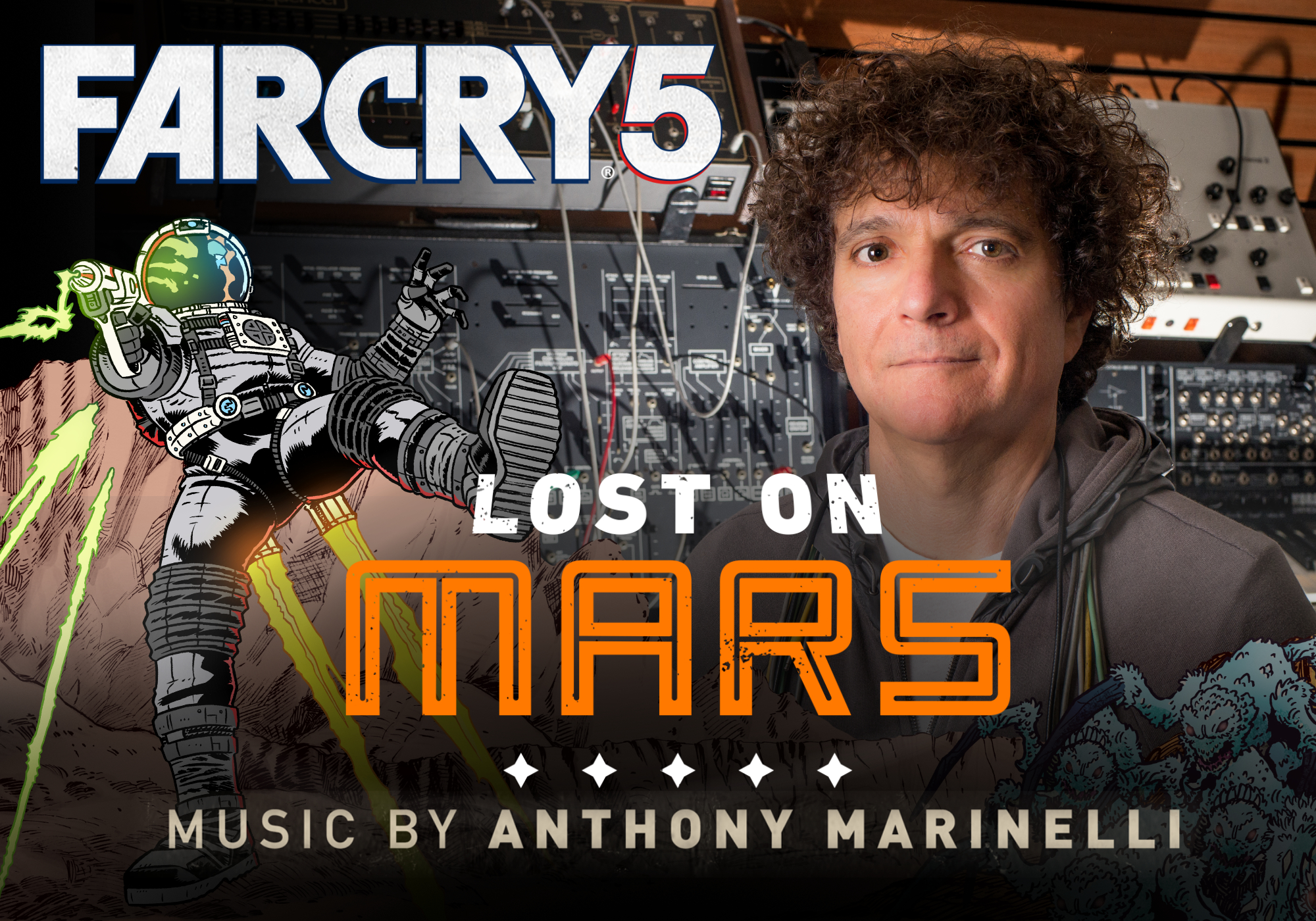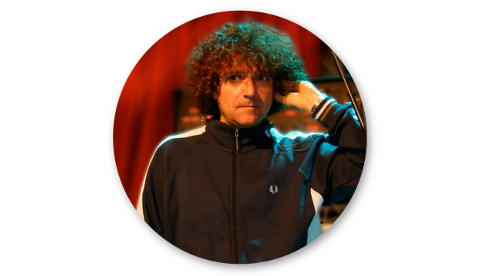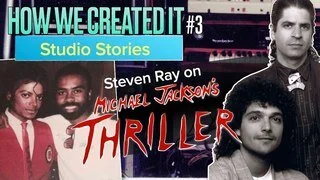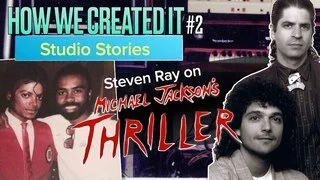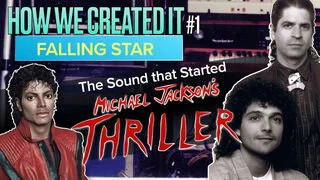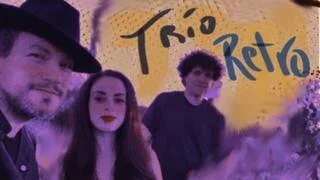by Mikel Reparaz / August 30, 2018 / 11 minute read
Dead Living Zombies, Far Cry 5's third post-launch adventure, is available now, completing a trilogy that has taken players to the jungles of Vietnam, the barren plains of Mars, and now, the zombie-infested imagination of a D-list horror-movie director. Each of these adventures needed a unique soundtrack to set the right mood, and Ubisoft turned to three distinct composers for the task.
For Lost on Mars, classically trained musician Anthony Marinelli – whose previous work includes playing and programming synthesizers on Michael Jackson's Thriller album – was brought on to set the mood for Hurk and Nick Rye's Martian adventure. Meanwhile, Hours of Darkness and Dead Living Zombies teamed Wade MacNeil – vocalist and guitarist of punk bands Gallows, Black Lung, and Alexisonfire – with movie and TV composer Andrew Gordon Macpherson, who also created the music for Far Cry Arcade. To find out more about how these soundtracks were created, we chatted with Marinelli, MacNeil, and Macpherson about their influences and their approach to each adventure's unique themes.
How familiar were you with Far Cry before composing music for Lost on Mars?
Anthony Marinelli: I've been aware of the Far Cry series since it first came out, and I was very excited to hear that Ubisoft was taking Far Cry into space, specifically Mars. My publishing company is actually named Man on Mars Music. Space exploration, and particularly Mars, have always been very inspiring to me. This was a perfect opportunity to create some really "out there" fun, spacey music.
I really like the music to Far Cry 3: Blood Dragon, I'm a huge fan of Power Glove – they're such gifted artists! They set the bar high with that score. That game and soundtrack of course has an ‘80s feel, so I knew Lost on Mars' retro soundtrack would be compared in some way. I felt a lot of pressure to create something unique and powerful.
Wade MacNeil: I had played the games. But now I see them in my sleep.
Andrew Gordon Macpherson: Blood Dragon was my first Far Cry experience, and definitely goes in my top 10. I love the feel of the gameplay, and I love the one-handed grenade launchers.
What information were you given before you started production? Did you get to play the game before?
AM: I traveled to Shanghai and met the Lost on Mars creative team so that we could start to collaborate on a musical direction. I was able to see early artwork, meet with game designers and the audio team, and watch how the whole process worked. In one room I'd see the concept art – the worlds, the weapons, crazy arachnids, maybe a few cows – and then, in the next room, I'd see those ideas come to life in actual gameplay, and get that feeling of immersion into a whole new world.
My favorite part, though, was the gravity belt. That exhilarating-but-almost-vertigo sensation of floating above the Mars surface really inspired the music for the towers. "Gravity Belt Boogie" has a real disorienting tone – dissonant synth cries, bending guitars, and all kinds of sounds flying by you.
AGM: We knew [Hours of Darkness] would be set in Vietnam during wartime, but didn't know much about the characters or mission. We knew the mood was going to be tense and hostile and somewhat hopeless. Outside of that, we didn't know much, but that was enough to get us started with sketching out the emotional feel and musical blueprint for the tracks. As we saw a bit more footage and art, we refined the compositions and collaborated with Kim Uyen Le to get the right instrumentation.
What mood were you trying to set with these soundtrack?
AM: After playing the early versions of the game, the overall feeling I got was a sense of adventure and exploration – fear, but with a whole lot of fun. So when I was told the stylistic direction was generally the music of the ‘70s, I thought "perfect!" The music and sounds of that time were adventurous – all those new electronic sounds and musical experimentation. It seemed like a great way to score the Martian landscape, a new territory for both Far Cry and its fans.
WM: [In Hours of Darkness,] you wake up in a cage at the start of the game. The soundtrack needed to fit that horrible realization. We wanted everything to sound bleak and hopeless. It needed to be scary but find moments of courage/strength. As you get closer to the extraction point, the score starts getting a bit stronger, tougher and more hopeful.
What are some of the techniques you use to evoke emotional responses from the player? How do you decide when and how to try and make them afraid, or empower them?
AGM: It's a combination of sound design and harmony and dissonance. With the right sound design, you can pretty much play one note over a shot of a jungle and know there's danger. So then it becomes imagining the emotional struggle you might need to overcome in this section of the mission, "painting" it with the chords, and then attacking that process with dissonance and sound design. Making the dissonance feel like it's big, but hidden in the jungle and ready to strike. We use a lot of EQ and filter automation into various reverbs to give things the space and size, and it also helps to create really nice melodic "smudges" that texturize the whole score.
What are some examples of tracks that you feel evoke an emotional response most strongly?
WM: Hopefully they all do! "Jungle Rot," I think, was the first track that we sketched, and really felt like it set the tone for the rest of what we would explore. "Upcountry" and "Elephant Grass" are both stealthy cues in the middle of the game, and I think they strike a good balance of the fear/finding courage that needed to resonate. "Haul Ass," "Hammer and Anvil," and "Walking Wounded" are the combat tracks where things really synthesized as far as the musical influences and emotion needed for chaotic jungle combat. "Agent Orange" is one that people react to really strongly – it had to be scary and a little druggy. We made a synth for it out of relentlessly distorted guitar bends, which ended up resurfacing on the Zombies score because it does such a good job accompanying big danger.
In Hours of Darkness, songs like "Light at the End of the Tunnel" and "By The Numbers" feel much more upbeat than other tracks; what inspired that change in tone?
WM: As the gameplay progresses, the musical tone changes. The beginning of the game is very cold-sounding and mostly built around traditional Vietnamese instruments. But as you continue through the game, the music shifts to being more triumphant, and we start bringing in more American rock and roll. It was fun to try and do something that felt like a ‘60s rock tune mixed with the "wall-of-sound" studio compositions of the time.
What was the biggest difference in composing for Dead Living Zombies, as opposed to Hours of Darkness?
WM: Having a supernatural element to the game allows us to make the score a lot more creepy. It gives us the opportunity to explore weirder noises and sounds, and incorporate them into the music.
AGM: The biggest difference was that each level on [Dead Living Zombies] really has a different musical style. So, unlike other scores, where you get to make a bunch of music with the same tools, we were starting from scratch each time we began writing. The key to creating a great horror soundtrack is making every single thing in the track clash with each other just a little bit. It puts you on edge.
How does composing a videogame soundtrack compare to other projects you've done in the past?
AM: Each project I work on has its own set of new requirements that are different from the last, so I'm constantly adjusting my processes and workflow to best serve that project. In that sense, this project was no different. But being my first videogame, I had to adjust how I wrote music in a few interesting ways.
Videogame music is loop-based, for the most part, so it can last for quite a long time if need be. Making music that is loopable by design was a new challenge. The starts and ends of each cue had to match up in intensity and instrumentation for the most part. If not, the player will definitely start hearing the loop. With film music, I'm used to having the freedom to have a sparse intro, build throughout the cue and end with a climax. That change in intensity builds interest, keeps the scene moving. I had to find other ways to keep up the interest. It's kind of a Zen paradox to always be there, never building too much, but still going in a direction that is interesting.
Thematic content is a big part of film music. This game required it as well, to a certain degree, but in a different way. Film music themes can often be heavily melodic and identifiable, to underscore a character and pivotal moments. But in a videogame, you never know exactly what will be happening on screen, so a hugely identifiable melody can either take a player out of the action, or repeat so often that the player starts to hear the loop. I tried to stick to smaller motivic melodies, riffs, and also thematic devices that relied less on melody and more on rhythm, instrumentation, and timbre. It's a fresh and valuable way of looking at music for me, one that will affect everything I create moving forward.
WM: I write melody for our scores the same way I do for an Alexisonfire song. It's usually the first idea that comes to me. I take a lot of inspiration from old punk and hardcore in my songwriting, and that's just as important in writing a theme for Far Cry or when I working on Alexisonfire's music.
What is special about the title tracks, and what made them representative of their respective adventures as a whole?
AM: The title track "Lost on Mars" includes a lot of the sounds that appear in the game, and is mostly a traditional western theme performed by vintage ‘70s synths to keep it tongue-in-cheek. There is also acoustic guitar, electric guitar, orchestral percussion, and theremin in the orchestration for extra western and sci-fi fun flavor. It contains a lot of sounds you hear throughout the game.
AGM: We had written that melody early on, but as soon as we heard Kim play it on the Dan Tranh, we knew that needed to be "Hours of Darkness." It was instant. It felt like that one lick, played on that instrument, was the "fingerprint" for the rest of the score.
How do you decide on the names of each track?
AM: After finishing the music, we had some help from a writer on the game to make sure the titles really connected to the story and gameplay. The names are pretty silly, to go along with the over-the-top nature of the game and the Far Cry series. It's so nice, at the end of a project, to hear all the cues back-to-back and finally give each piece a proper name. Then they're ready for the world.
WM: I have a pretty exhaustive list of song titles going at all times. Then, it was a matter of doing some research on wartime slang and history, and combining everything into the title the fit the piece.
What's your favorite track and why?
AM: My favorite track is "Yeti Meltdown." It makes the speakers physically pump in and out, even at low volume. I like the funky Minimoog bassline, along with the wacky harmony created by the retro ‘70s sci-fi orchestra samples. It's quite extreme in punchiness, and sounds unique to me in an old-meets-new kind of way.
AGM: The entire score was a blast, and they're all near and dear to our hearts, but "Thunder Road" may have been the most fun to make. It's built out of a jam where Kim encouraged Wade to play the Moon Lute while she played Dan Tranh over a rhythm track that I had sketched out.
Lost on Mars, Hours of Darkness, and Dead Living Zombies are available now to Far Cry 5 owners, either for individual purchase or through the Season Pass. For more on the game, check out our previous Far Cry 5 coverage.
ESRB - M

